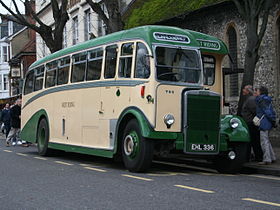Leyland Tiger (front-engined)
| Leyland Tiger (TS) | |
|---|---|

North Western Leyland Tiger TS7
|
|
| Overview | |
| Manufacturer | Leyland Motors Ltd. |
| Body and chassis | |
| Doors | 1 door as standard, various options with coachwork |
| Floor type | Step entrance |
| Powertrain | |
| Engine | Leyland Motors 6-cylinder in-line OHC. Petrol 6.5, 7.4 or 10.5 litre or diesel 8.6 litre direct injection |
| Capacity | 28-39 seats |
| Transmission | Leyland 4-speed sliding mesh, later constant-mesh with optional external overdrive unit, or from 1933-39 Leyland Lysolm-Smith Torque Converter. |
| Dimensions | |
| Length | 27 ft 6 in (8.5 m) to 30 ft (9.2m) |
| Width | 7ft 6 in |
| Chronology | |
| Leyland Tiger (PS) | |
|---|---|

West Riding Leyland Tiger PS2
|
|
| Overview | |
| Manufacturer | Leyland Motors |
| Body and chassis | |
| Doors | 1 door as standard, various options with coachwork |
| Floor type | Step entrance |
| Powertrain | |
| Engine | (PS1) Leyland E181 7.4-litre 6-cylinder ohv diesel engine (OPS1) Leyland E87 8.6-litre ohc diesel engine (PS2, OPSU2, OPSU3) Leyland O600 9.8-litre ohv engine (OPSU4) Leyland 600 or Leyland 680 11.1-litre engine |
| Transmission | (PS1/OPS1) Leyland constant mesh, 4 speeds (PS2/OPSU2,3,4/1,4) Leyland Synchromesh 4 speeds (OPSU4/2,5) Leyland-Self-Changing Gears Pneumocyclic direct selection semi-automatic, 4 or 5 speeds |
| Dimensions | |
| Length | 27 ft 6 in (8.5 m) to 36 ft (11 m) |
| Chronology | |
The Leyland Tiger was a heavyweight half-cab single-decker bus and coach chassis built by Leyland Motors between 1927 and 1968, except the period of World War II.
The Tiger was always very closely related to the Titan of its time, sharing a ladder type frame dropped in the wheelbase and gently rising in curves over the axles, generally only differing in wheelbase.
In conjunction with the original Titan, Leyland Motors offered the same mechanical advances in a single-deck bus or coach chassis, in half-cab (forward-control) form this was called the Tiger, with normal-control derivatives with the driver behind the engine bonnet and sharing the saloon with the passengers generally being called Tigress. The Tiger from 1927-42 went through derivatives from TS1 to TS11.
The Leyland Titan TD1 was unveiled at the Commercial Motor show at London's Olympia exhibition hall in November 1927, it was then unique amongst double deckers in having a light enough frame to run two-axled on pneumatic tyres (two at the front and four at the back) yet carry 52 passengers in a bus of 25 ft overall length, with such refinements as a six-cylinder overhead-camshaft petrol engine and an unprecedentedly-low frame. The Tiger TS1 was its single–deck counterpart. The wheelbase was slightly longer at 17 ft 6in allowing bodywork up to 27 ft 6in long, with up to 35 seats. The first Tiger TS1 (chassis 60001A), bodied by Leyland was loaned in March 1927 to H.M.S. Catherwood Ltd of Belfast, it was purchased by them and, sold to other firms, it worked in Ireland until 1940.
At the time the Tiger was launched there were no rules across Great Britain on a bus or coaches overall dimensions, these depended on what a local council empowered to licence vehicles to an operator would allow.
In response to varied demand the TS1 was curtailed to become the TS2, which had the same wheelbase but an overall body length of 26 ft and then the TS3 was introduced for the same body length, but with the Titan's 16 ft 7in wheelbase. Later the TS8 was revised with a shorter bonnet to become the TS8 (special). SMT and Alexanders especially favoured that type as it could seat 39 rather than 35 in the 27 ft 6in maximum length allowed for two-axle single deckers (see later).
Not only did the Tiger catch the imagination of British Isles fleet-owners looking for better performance from their buses and coaches it also sold overseas to Sweden, South Africa, India, New Zealand, Canada, Argentina and Australia, the Canadian versions being lengthened to a 19 ft wheel-base, for a 30 ft body and having the engines uprated to 100 bhp, geared to a top speed of 60 mph.
...
Wikipedia
